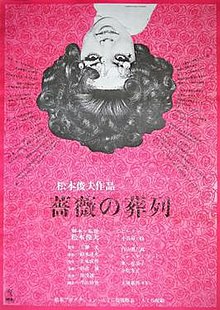Funeral Parade of Roses
| Funeral Parade of Roses | |
|---|---|

Japanese film poster
|
|
| Directed by | Toshio Matsumoto |
| Produced by | Mitsuru Kudo Keiko Machida |
| Written by | Toshio Matsumoto |
| Starring |
Pîtâ Osamu Ogasawara Yoshio Tsuchiya Emiko Azuma |
| Music by | Joji Yuasa |
| Cinematography | Tatsuo Suzuki |
| Edited by | Toshie Iwasa |
| Distributed by | Art Theatre Guild |
|
Release date
|
|
|
Running time
|
105 minutes |
| Country | Japan |
| Language | Japanese |
Funeral Parade of Roses (薔薇の葬列 Bara no Sōretsu?) is a 1969 Japanese drama film directed by Toshio Matsumoto. It is a loose adaptation of Oedipus Rex set in the underground gay counterculture of 1960s Tokyo. The film was released by ATG (Art Theatre Guild) on 13 September 1969 in Japan; however, it did not receive a US release until October 29, 1970. Matsumoto's earlier film For My Crushed Right Eye contains some of the same footage and could almost be seen as a trailer for Funeral Parade of Roses, although a true trailer was also made.
An important work of the Japanese New Wave, Funeral Parade of Roses combines elements of arthouse, documentary and experimental cinema.
The film was a major influence on Stanley Kubrick's 1971 film A Clockwork Orange.
The film follows the trials and tribulations of Eddie and other transvestites in Tokyo. The title is a pun, "rose"/"Bara" in Japanese is similar to the use of the word "pansy" in English slang.
The film was set and shot in Tokyo.
...
Wikipedia
